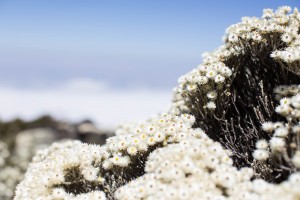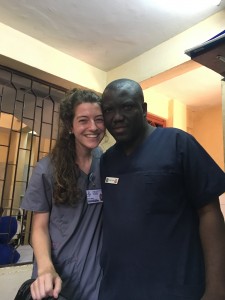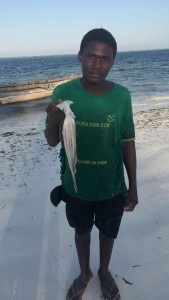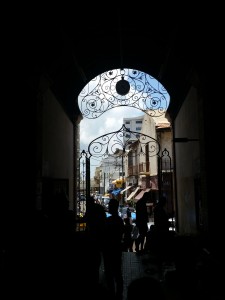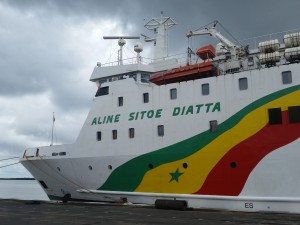Jour 88 – C’était le rendez-vous des maitres formateurs aujourd’hui. Ils ont discuté de la stratégie pour partager la bonne nouvelle avec leur propre argent, sans aide des missionnaires. Oofi m’a dit qu’il voudrait acheter un grand steak aux Etats-Unis. On a visité le village artisanal, j’ai acheté même plus de souvenirs.
Jour 89 – J’ai pris l’avion de Ziguinchor à Dakar ce matin. Peut-être c’est impossible de scanner les bibles, main chaque aéroport m’a fait ouvrir mes boites de bibles. J’ai fait une promenade autour de mon quartier. Le logement ici est exactement comme un hôtel, mais c’est beaucoup moins cher. J’ai discuté et ai joué du ping-pong avec le gardien et son frère. J’ai pris une sieste et ensuite j’ai mangé à Southern Fried Chicken (main le propriétaire est anglais…).
Jour 90 – J’ai assisté une église baptiste aujourd’hui avec Brad et Josh. C’était vraiment énergique et a duré 2h 20. Après nous avons mangé à un resto près de la mer. Brad m’a amené pour voir le phare, c’était une belle vue. J’ai regardé les films Beasts of No Nation and Good Will Hunting. J’ai encore mangé à Yum Yum et ensuite j’ai mangé une crêpe avec banane et Nutella. J’ai appelé mes parents.
Jour 91 – J’ai visité le centre baptiste à Grand Yoff aujourd’hui. Rachel vient de Nashville mais malheureusement elle et son mari soutiennent Vanderbilt. Ils enseignent les cours d’anglais. J’ai fait une promenade avec Brad aux quartiers de Dakar. On a visité l’île touristique et artistique, Ngor. C’est beau là-bas. J’ai mangé des pâtes italiennes et j’ai appelé mes sœurs.
Jour 92 – Ce matin on a fait l’évangélisation au Centreville de Dakar. Après on a mangé à Classic Burger, le seul restaurant en ville qui fait bien les hamburgers. Nous avons fait une petite promenade dans les rues et ensuite somme rentré chez nous. J’ai tapé mon blogue. Je ne sais pas pourquoi exactement j’ai commandé un hotdog sénégalais, mais j’étais déçu comme toutes les autres choses américaines que j’ai commandées ici. J’ai eu une discussion avec Oumar sur le mariage, il m’a dit que sa mère lui a dit qu’un homme a un choix dans un mariage : avoir raison ou être content. Il ne peut pas avoir les deux.
Jour 93 – J’ai tapé mon blogue ce matin. J’ai joué deux matchs de ping-pong avec Oumar, c’était 1-1. J’ai mangé à la VDN avec Brad, Jicole et le nouveau couple américain. Après on a payé une facture avec Brad et est allé à l’université. C’était bien mais j’aime Belmont de plus. J’ai mangé chez Oumar pour dîner, du yassa poulet.
Jour 94 – Aujourd’hui on a visité l’île de Gorée, c’était vraiment beau là-bas. De nos jours, c’est une île très touristique, ça veut dire j’ai trouvé moins d’histoire que je pensais et plus de boutiques pour acheter des souvenirs. Je n’avais pas besoin de plus de souvenirs, mais j’ai acheté une peinture en verre, j’espère ne pas la casser pendant le retour. Je ne sais pas comment il est possible d’avoir 15 boutiques touristique côté à côté avec les mêmes souvenirs. C’est une ancienne base militaire aussi avec les canons et tout ça.
Jour 95 – Ce matin on a eu un rendez-vous au centre baptiste à Grand Yoff. C’était la plupart des missionnaires et quelques sénégalais. On a fait une étude de la Bible sur Mattieu 15. Les garçons ont marché le retour et ont mangé à un resto dans la rue. J’ai finalement trouvé mon cher planet orange, une boisson gazeuse que je cherchais les dernières 5 journées. Pour souper on a mangé au bord de la mer, c’était bon mais cher. J’ai presque dépensé tout mon argent, mais il me reste 2 jours. Presque là.
Jour 96 – On voulait aller à la plage mais il pleuvait toute la journée. Plutôt on a visité Le Monument de la Renaissance Africaine. Il y a une belle vue en haut. J’ai mangé à N’ice Cream. Pour souper, Jicole a fait « meatball subs ».
Jour 97 – On est allé à l’église ce matin. C’était bon mais la musique n’était pas la meilleure. Il a presque duré 3 heures. Après on a mangé du jambon et a passé la journée chez Brad et Jicole.
Day 88 – It was the meeting with the master trainers today. They discussed the strategy for sharing the Gospel with their own money, without help from the missionaries. Oofi told me that he would like to buy a big steak in the United States. We visited the artisanal village and I bought even more souvenirs.
Day 89 – I took the plane from Ziguinchor to Dakar this morning. Maybe it’s impossible to scan bibles but each airport made me open my boxes of bibles. I took a walk in my neighborhood. The accommodations here are just like a hotel, but way less expensive. I talked and played ping-pong with the guard and his brother. I took a nap and then I ate Southern Fried Chicken (but it might be a rip-off because the owner is English…).
Day 90 – I attended a Baptist church today with Brad and Josh. It was very energetic and the service lasted 2 and a half hours. After, we ate a restaurant next to the sea. Brad brought me to see the lighthouse, it had a great view. I watched the films Beasts of No Nation and Good Will Hunting. I ate at Yum Yum again and then had a crepe with banana and Nutella. I called my parents.
Day 91 – I visited the Baptist Center today in Grand Yoff. Rachel comes from the Nashville area but unfortunately her and her husband support Vanderbilt. They teach English courses as a ministry. I took a walk with Brad through the neighborhoods of Dakar. We visited the tourist island, Ngor, that is also known for its art. It’s quite beautiful over there. I ate some Italian pasta and called my sisters.
Day 92 – This morning I shadowed some evangelization walks downtown. Afterwards we ate at Classic Burger, the only restaurant in town that makes good hamburgers. We took another walk through the streets and then returned home. I typed my blog. I am not entirely sure why I ordered a Senegalese hotdog, but it was pretty disappointing like all the other American things I have ordered here. I had a discussion with Oumar on marriage, he told me that his mom told him that a man has a choice in marriage: to be right or to be happy. He cannot be both.
Day 93 – I typed my blog this morning. I played two matches of ping pong with Oumar, the score is 1-1. I ate at the VDN with Brad, Jicole and the new American couple. Afterwards, we went to go pay a bill with Brad and then visited the university in town. It was nice but I like Belmont better. I ate at Oumar’s house for supper, some chicken yassa.
Day 94 – Today we visited Goree Island, it is really beautiful over there. Nowadays, it is a very touristy island, which means there was less history than I thought and more shops to buy souvenirs. I did not need any more souvenirs, but I bought a glass painting, I hope to not break it on the way home. I do not know how it is possible to have 15 shops side by side that all sell the same things. It’s also a former military base, so it had some cannons and tunnels.
Day 95 – This morning we had a meeting at the Baptist center in Grand Yoff. It was the majority of the missionaries here and some Senegalese. We did a bible study on Matthew 15. The guys walked back and ate a restaurant in the street. I finally found my precious Planet Orange, a carbonated beverage I had been looking for all week. We ate at a restaurant by the sea for supper, it was good but expensive. I have almost spent all of my money, but I only have two days left. Almost there.
Day 96 – We wanted to go to the beach but it rained all day. We visited the Statue of the African Renaissance. It was a beautiful view at the top of the steps. I ate at N’ice Cream. For supper, Jicole made some meatball subs.
Day 97 – We went to church this morning. It was good but the music was not the best. The service lasted about 3 hours. Afterwards, we ate some ham and spent the day at Brad and Jicole’s house.

